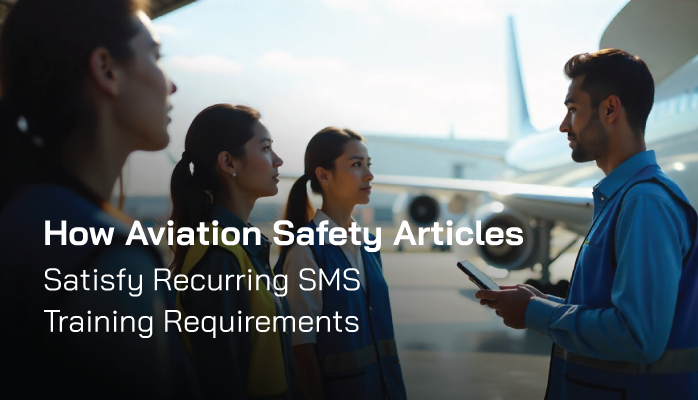Aviation SMS Training Does Not Have to Break the Bank

In Phase 2 and Phase 4 of an ICAO compliant aviation safety management system (SMS), aviation service providers must
- Deliver training relevant to reactive risk management processes; and
- Develop training relevant to operational safety assurance.
SMS training requirements have both initial and recurrent components. This means that operators cannot simply throw money at the SMS training problem and hope for a quick fix. SMS training is a long-term, ongoing commitment to safety.
Furthermore, SMS auditors and management must assure:
- SMS training is current;
- Provided SMS training satisfies need;
- SMS training has been documented; and
- Safety training policy satisfies regulatory intent.
In this article, we'll discuss how service providers can effectively use aviation safety articles to comply with regulatory requirements regarding SMS training programs. In addition, we'll offer a blueprint to easily deliver aviation SMS training to general line employees and managers.
Finally, we will provide a free SMS training resource to get you started.
Related Aviation SMS Training Articles
- What Is Aviation Safety Training in Aviation SMS - Includes Videos to Use
- Why Employees Can’t Stand Aviation SMS Training
- 4 Pillars | 10 Things You Need to Know About Aviation Safety Training
If SMS Training Participation Not Documented, It Never Happened
Documentation is key. If it isn't documented, it didn't happen. Documentation requirements revolve around:
- Safety training policies and objectives;
- Safety training standards; and
- Tracking employee training activities.
Aviation safety managers are challenged with:
- Providing SMS training in a timely, efficient manner;
- Ensuring training meets requirements; and also
- Assuring management that SMS training aligns with often very lean safety budgets.
SMS Training Based on Employee Duties and Requirements
Not all employees require the same level of training. For example, most line employees require training on:
- Hazard identification;
- How to report accidents, incidents, and irregularities;
- Safety policies;
- Organizational structure of the safety program;
- Their duties and requirements regarding the safety program; and
- A high-level overview of the nature and requirements of your safety program.
Most service providers implementing aviation SMS do fairly well with initial SMS training. Typically, they attend a watered-down SMS training course provided either by the safety manager or an outside SMS consulting company. The most effective training is automated SMS training programs.
Related Aviation SMS Training Articles
- Aviation Safety Management Training Made Simple
- Understanding Role of Hazard Identification Training and Safety Reporting Forms in Aviation SMS
- 3 Biggest Aviation SMS Training Course Mistakes
Benefits of Automated SMS Training Programs

As stated, SMS training requirements are not overly complex for most line employees. An automated training program that is provided online offers many advantages, including:
- Access by all employees with Internet connectivity;
- Training available around the clock;
- More cost-effective;
- Flexible and easy to adapt to each region or employee group;
- Standardized, meaning all employees receive the same level of SMS training; and
- Highly accepted by younger generations.
Quality control is more easily managed using online training. Customized SMS training programs can be developed for each user group, such as
- line employees,
- safety managers,
- department heads and
- executives.
Automated, online training is cost-effective and highly convenient to all user groups. SMS training budgets are reduced for standard expenses, such as:
- SMS trainer or consultant;
- Employee commuting time;
- Classroom rentals; and
- SMS training materials, such as brochures or printouts.
There is an expense of creating the training, but this is a one-time expense. Furthermore, there are considerable amounts of training materials put out by ICAO, civil aviation authorities, SMS training schools, and SMS consultants. The majority of these SMS training materials are free and available online.
Related Aviation SMS Training Articles
- 5 Signs of Good Aviation Risk Management Training
- SMS Chart: Where to Focus Hazard Identification Training & Risk Mitigation
- Most Common Misconceptions About Aviation Risk Management Training
Recurrent SMS Training Made Easy
Once employees have received their initial SMS training, recurrent training must be considered. There are no identifiable standards as to what elements must be taught in recurrent SMS training. Furthermore, recurrent training has no stated time interval as to when the initial SMS training elapses. Best practices show that recurrent SMS training should be provided every 12-18 months.
What should your recurrent SMS training look like? I recommend that you keep it simple and not bore line employees. Certain employee groups require comprehensive SMS training, such as
- Safety and QA managers;
- Department heads; and
- Executives.
The remaining employees' training can be as simple as reading educational safety articles. Again, this training must be documented.
Safety Article Training Library
Online databases are excellent tools to provide libraries filled with aviation safety articles that can be used for recurrent SMS training. These safety article libraries will hold hundreds of aviation safety articles based on categories, such as:
You may have noticed these categories follow the four pillars or components of aviation SMS.
In most cases, employees should be encouraged to browse safety articles and find topics that interest them. A best practice is to have your safety article library online and automatically track employee activity. Safety managers can easily remind employees to perform their recurrent SMS training using the automated safety training article library.
A poor man's approach is to have a spreadsheet with links to educational safety articles. The problem with the spreadsheet approach is the lack of automatically tracking and documenting employee SMS training activities.
Have You Read
- 5 Things Spreadsheets Can’t Do for Your SMS
- Spreadsheets vs Software for Aviation Safety Management
- How Spreadsheets Not EASA Compliant Aviation Safety Reporting Database
Final Thoughts Using Safety Articles for Recurrent SMS Training
Educational aviation safety articles offer many benefits to service providers struggling to comply with regulatory requirements. These educational articles are typically written by subject matter experts and are freely available. The best safety articles will include free resources, such as checklists and templates to further employee interest and education.
Recurrent SMS training does not have to be expensive. Finally, tracking and documenting recurring SMS training should not become so laborious as to discourage safety managers. These mundane data entry tasks should be automated by your aviation SMS database program.
You can create your own SMS training library using this list of over 300 educational safety articles. If you are an SMS Pro user, look for the aviation safety article training library under "Safety Promotion."
If you need a way to automate SMS training for the bulk of your company's employees, check out SMS Pro. We can automate both initial and recurring SMS training. Since 2007, SMS Pro has been providing aviation SMS database services to operators around the world. Learn how we can help you reach SMS compliance.
Last updated in November 2025.







